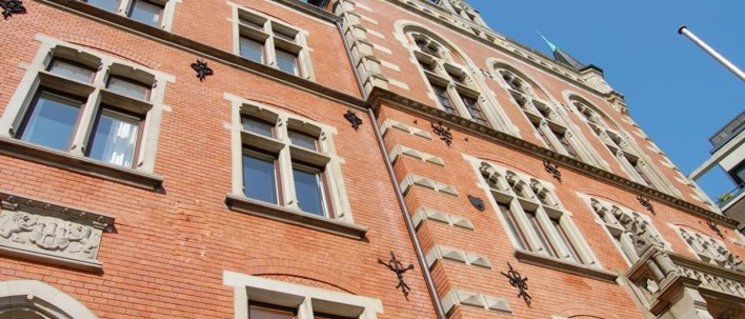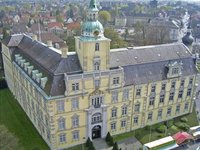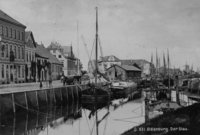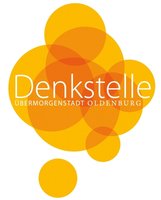History of Oldenburg
From a fortress to the Übermorgenstadt: The history of the City of Oldenburg
The earliest traces of human activity in the Oldenburg region were found to the west of the city in Bloherfelde when the State Office for the Preservation of Historical Monuments of Lower Saxony discovered around 40 fireplaces from the Mesolithic Age – between 8,500 and 4,000 B.C. The archaeologists assume that these were used for cooking by stone-age hunters and gatherers. It is also assumed that this area was used regularly for a long period of time, perhaps even for centuries.
When building first started in the city's industrial area at the East Harbour at the Ikea site, between the Hemmelsbäker canal and the Hunte in the early spring of 2007, a historical circular wall system with a diameter of 35 to 40 metres was rediscovered. This was possibly a predecessor of the Grafenburg in Oldenburg's city centre. The fortress wall referred to as the "Heidenwall" in historical maps originates from the first half of the 11th century and protected the former Hunte ford.
Since ancient times the city of Oldenburg has marked the important river crossing between the Delmenhorst and the Oldenburg-East Frisian Geest, the coastal moorlands, at the point where it used to be easiest to cross the extended moor and marsh areas between the Weser and Ems (the "Frisian Military Road"). In addition the city's location at the former tidal limits (port, docks and reloading point), in a similar position to that of Hamburg and Bremen, gave important impetus to the development of the early settlement.
First documented evidence as Aldenburg in 1108
As its name suggests, the city of Oldenburg was founded as an ancient castle fortress and was first mentioned in records as "Aldenburg" in 1108. The fortress was erected on the top of a Geest, above the high tide mark, in the middle of the marshy Hunte valley and was used for protection and as a toll house of the people of the Count of the Ammerland (later to become Count of Oldenburg) on the major trade route from Bremen and Westphalia to Frisia, which followed a dam through the lowlands in the border area between Saxony and Frisia. The road still runs through the city in an almost north-south direction (hence the street names Lange Strasse (long street), Damm).
Documents show that in the year 1108 the former Count Egilmar I of Oldenburg was accepted into the Brotherhood of Iburg Monastery at his own request. In return Graf Egilmar was to donate ninety bundles of eels to the Iburg abbot every year on Maria's birthday (8th September). This historical event was documented and also is the first mention of the name of Oldenburg, which was recorded as Aldenburg at the time.
Traders and artisans settled under the protection of the fortress in the 12th and 13th centuries (1224: documented further construction of the Lamberti church, 1243: two annual markets). In 1345 it was granted its town charter (first town hall in 1355) and in the 14th century also gained in importance as a commercial site and port (first mentioned in 1383).
Changes in rulers from the 17th to the 19th century
The most prominent counts of Oldenburg were Christian (elected King of Denmark in 1448) and especially Anton Günther (1583-1667). He was able to protect his lands against the destruction and devastation of the Thirty Year War by means of generous gifts and diplomatic neutrality policies.
In 1667 the city fell to the Danish crown by inheritance. In 1672 to 1679 the first stage of extension to the fortress was completed. The Danish Viceroy resided in the city until 1773. During this period Oldenburg suffered considerable economic and political losses, which were partly due to the Great Fire of 1676. At the end of Danish rule, in 1773 Oldenburg once more became a residence under Friedrich August of the house of Holstein-Gottorp, and as a duchy was the centre of a country which stretched from the coast through to the Dümmer lake and from Bremen almost through to the Hümmling. From 1810 to 1813 Oldenburg belonged to the French Empire.
The buildings and landmarks of five centuries still characterise the city, including the St. Lamberti church (originally from the early 12th century), the Lappan Tower (1467), the Degode House (1502), the Palace (conversion of the Medieval castle from 1607), the classicist row of houses on the Huntestrasse (from 1791), the 18 hectare Palace Gardens (from 1803), the Prince's Palace (1821), the Peter Friedrich Ludwig Hospital (1838), the Palace Guard (1839), the Augusteum (1867), the Elisabeth Anna Palace (1893); the State Theatre (1892/93).
En route to modernity: the 19th century
The town's transition to a residence, military centre and "town of civil servants" as well as a retirement area was accompanied by a fast growth in its population (1821: 9,446, 1848: 15,087, 1871: 25,275 inhabitants). Since the middle of the 19th century it has been technically possible to build settlements in lower-lying areas of the city. For example the Dobben quarter with its villas from the Gründerzeit, the "Foundation Epoch", were built in 1875. In the same way the port and railway quarter were erected after the railway links were built (from 1867) and the construction of the Hunte-Ems canal (1855-1893) in the east of the city.
In contrast, industrialisation was kept within modest limits. From 1846 the Oldenburg glassworks which made wine bottles, partly for Spain and Portugal, was located next to the warp spinnery founded in 1856. The works gained significantly in importance after the regulation of the Hunte (up to 1898) and the foundation of the Oldenburg-Portuguese steam shipping company (1882).
In the 20th century Oldenburg grows into a city
When the last grand duke Friedrich August abdicated in 1918, the first government of the "Free State of Oldenburg" was elected in 1919. New, planned residential areas were built between the wars on the outskirts of the city (Bürgerfelde). With the incorporation of Osternburg (1922), Eversten (1924), Nadorst, Ofenerdiek, Ohmstede and Etzhorn (1933), the city area expanded from 1,152 hectares (1919) to around 10,297 hectares (1935).
Under National Socialist rule, Oldenburg was a main Gau centre. In 1945 the state of Oldenburg was reinstated by the Allies and in 1946 it was incorporated into the federal state of Lower Saxony.
Since then the city has been the seat of the regional government (administrative district of "Oldenburg", then from 1978 "Weser-Ems".) In 2004 the regional governments were dissolved throughout the federal state. Instead, in 2005 Oldenburg was assigned a "governmental office" by resolution of the federal state government. Oldenburg remained largely unaffected by the devastation of World War II. At the end of the war the city, which at the time only had 80,000 inhabitants, faced the tremendous challenge of absorbing the influx of more than 40,000 refugees, and as a result suddenly became a city overnight.
During the post-war years building was resumed with gusto, fuelled by the renewed economic upturn. New residential areas were designated and existing settlement gaps were closed. The number of inhabitants continued to grow and continuously increased in the following decades (1950: 122,809, 1961: 125,198, 1970: 131,545, 1987: 139,679, 1997: 153,531, 2001: 155,908, 2004: 158,000, 2010: 158,233, 2012: 159,329). Oldenburg is now on its way to becoming the third largest city in Lower Saxony behind Hanover and Braunschweig. This positive development is in stark contrast to almost all other cities which have lost a small to large share of their population in recent decades.
Launching pad for the future: Oldenburg named the "City of Science"
The former residence of counts, dukes and grand dukes is now a busy university city and as the major centre between the Weser and Ems is the administrative, economic and cultural hub of North West Lower Saxony. Since 2005 the Bremen/Oldenburg region has been a recognised European metropolitan region.
In 2008 the Stifterverband für die Deutsche Wissenschaft, the national innovation agency for German science, awarded Oldenburg the title "German City of Science 2009". This title is awarded to cities which have succeeded in creating networks between scientific, business and cultural circles to make use of these networks in the long term for the development of the city.
The "City of Science" project is not limited to the year 2009, but is an ambitious and long-term project for the city's development. The "Übermorgenstadt" concept is geared to science, dynamism and innovation. Oldenburg is a city full of creative and clever minds and wants to stay that way in the future.
These new lines of development make Oldenburg a modern city with its sights firmly set on the future, but which is still proud of its appealing charm as a residence city with good old traditions.
Zuletzt geändert am 21. November 2022















 zurück
zurück